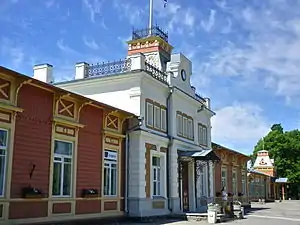Haapsalu
Haapsalu (Estonian pronunciation: [ˈhɑːpsɑlu]) is a seaside resort town located on the west coast of Estonia. It is the administrative centre of Lääne County, and on 1 January 2020 it had a population of 9375.[1]
Haapsalu | |
|---|---|
 View from Haapsalu Castle | |
 Haapsalu Location of Haapsalu in the Baltic Sea region .png.webp) Haapsalu Location in Estonia  Haapsalu Location in Europe | |
| Coordinates: 58°56′22″N 23°32′27″E | |
| Country | |
| County | |
| Municipality | |
| Town rights | 1279 |
| Area | |
| • Total | 11.09 km2 (4.28 sq mi) |
| Elevation | 10 m (30 ft) |
| Population (2020)[1] | |
| • Total | 9,375 |
| • Rank | 14th |
| • Density | 850/km2 (2,200/sq mi) |
| Ethnicity | |
| • Estonians | 81% |
| • other (Finns, Swedes, Russians) | 19% |
| Time zone | UTC+2 (EET) |
| • Summer (DST) | UTC+3 (EEST) |
| Postal code | 90503 to 90507 |
| Area code(s) | (+372) 047 |
| ISO 3166 code | EE-184 |
| Vehicle registration | S |
Description
Haapsalu has been well known for centuries for its warm seawater, curative mud and peaceful atmosphere. Salt mud spas frequented by the Russian Romanov family still operate. Narrow streets with early 20th century wooden houses lead to the sea. Haapsalu has been called the "Venice of the Baltics",[2] although this claim has been criticized as an exaggeration.[3] The name "Haapsalu" is from Estonian haab 'aspen' and salu 'grove.'[4] In Swedish and German, the town is called Hapsal, and in Russian it is Га́псаль (Gapsal).
History

The town dates back to 1279, when it was chartered and became the centre of the Bishopric of Ösel-Wiek, which it remained for the next 300 years. Buildings from those early days remain today, including an episcopal castle which has the largest single-nave cathedral in the Baltic states, Haapsalu Castle.
Haapsalu and the surrounding area was the center for the Estonian Swedes from the 13th century until the evacuation of almost all ethnic Swedes from Estonia in 1944.
Neighborhoods of Haapsalu
There are six neighborhoods of Haapsalu:
- Holmi
- Kesklinn
- Männiku
- Paralepa
- Randsalu
- Vanalinn.[5]
Healing spas
For many years, locals have claimed that the sea mud has a curative effect. A military doctor, Carl Abraham Hunnius, founded the first mud cure resort in 1825. News of the curative mud quickly reached the aristocracy of Saint Petersburg, the capital of the Russian Empire. Ever since then, Haapsalu has been a popular summer destination where people from all around the world come for medical treatment. Today, there are three mud cure establishments in Haapsalu varying in size and location.
Haapsalu shawl
In the 19th century, Haapsalu became famous for its shawls, a delicate craft made by local women.
Other attractions
The Land of Ilon Wikland (Wiklandia), a recreation centre for children, is set to open in a few years within the town. This world-famous book illustrator has been involved with Haapsalu since her childhood.
The August Blues Festival is held every August in Haapsalu.
Since 2005 the town hosts Haapsalu Horror and Fantasy Film Festival, an annual film festival dedicated to genre films.[6] In 2017, the pastors of Haapsalu made an open statement calling to end the city's financing of the festival, claiming the horror and violence depicted in the screened films were not fit to represent the resort town image.[7] The same year the festival was held to a record-breaking attendance.[8]
In popular culture
Haapsalu is site of a fencing school founded by Estonian fencer Endel Nelis, used as the setting of the Finnish-Estonian film The Fencer.[9]
Gallery
 Central square
Central square City center
City center Haapsalu resort hall
Haapsalu resort hall Boats in gulf Tagalaht
Boats in gulf Tagalaht Haapsalu Railway Station, now disused, and notable for the length of its platform canopy.
Haapsalu Railway Station, now disused, and notable for the length of its platform canopy. Town Hall
Town Hall Train station
Train station Water tower
Water tower Train station polyclinic
Train station polyclinic Steam locomotive
Steam locomotive A pavilion at Haapsalu seaside promenade
A pavilion at Haapsalu seaside promenade Sculpture "Kepimurdja", by Juhan Raudsepp
Sculpture "Kepimurdja", by Juhan Raudsepp View from the promenade
View from the promenade Jaani church
Jaani church Orthodox Church of St. Mary Magdalene
Orthodox Church of St. Mary Magdalene
References
- "Population number, area and density. administrative division as at 01.01.2018". Statistics Estonia. Retrieved 1 June 2020.
- Dallen J. Timothy (18 May 2009). Cultural heritage and tourism in the developing world: a regional perspective. Taylor & Francis. pp. 239–. ISBN 978-0-415-77621-9. Retrieved 17 January 2012.
- Derek R. Hall; Melanie K. Smith; Barbara Marciszewska (30 November 2006). Tourism in the new Europe: the challenges and opportunities of EU enlargement. CABI. pp. 264–. ISBN 978-1-84593-117-9. Retrieved 17 January 2012.
- E.M. Pospelov, Geograficheskie nazvaniya mira (Moscow, 1998), p. 444.
- "LINNAOSADE JA -JAGUDE LÜHENDID". www.eki.ee (in Estonian). Retrieved 18 March 2020.
- Thomas M. Sipos (2012). Horror Film Festivals and Awards. McFarland. ISBN 9780786465729
- "Haapsalu pastorid tegid pöördumise HÕFFi vastu - Lääne Elu". le.ee. 23 March 2017. Retrieved 13 April 2018.
- "HÖFF tõi rekordi". postimees.ee. Retrieved 13 April 2018.
- Reiljan, Kaire (16 March 2015). ""Vehkleja". Kaks lugu, elu ja tõde filmis" ["The Fencer". Two stories, life and truth in film] (in Estonian). Lääne Elu. Retrieved 9 January 2016.
External links
| Wikimedia Commons has media related to Haapsalu. |
| Wikivoyage has a travel guide for Haapsalu. |
